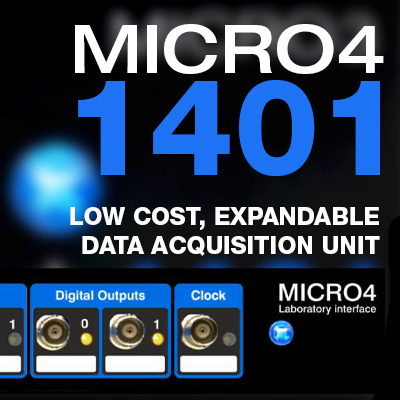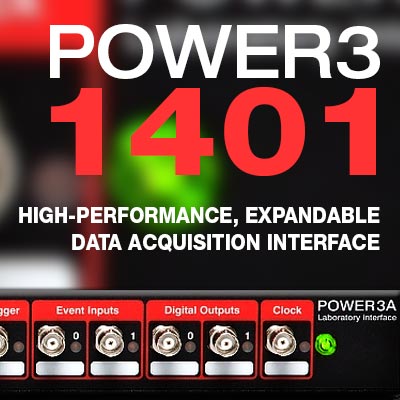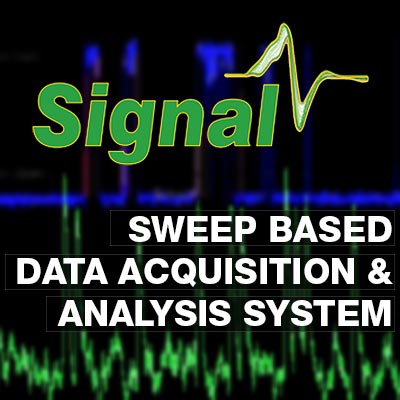CED Power 3
The Power1401-3 is CEDs high-performance data acquisition unit compatible with both Spike2 and Signal software suites. Faster clock and more memory translates to all the power and flexibility required in a state fo the art laboratory acquisition system.
Fast Data Acquisition And Analysis
The Power3 records waveform data and digital event and marker information, and can simultaneously generate waveform and digital outputs in real-time for multi-tasking experimental control. It features high-speed waveform capture at rates up to 1GHz with 16-bit resolution. The 32-bit RISC processor allows complex on-line analysis while freeing time for the host computer to perform other tasks, such as data manipulation and further analysis.
CED Power 1401-3 Data Acquisition Unit Features
- 16 channels of 16-bit waveform input on base unit
- 1 Gbyte memory expandable to 2 Gbytes
- Dynamically programmable amplifier option
- Software-selectable ±5V or ±10V input and output ranges
- Synchronisation with other CED 1401s for large numbers of channels, all accurately timed
- USB 2.0 high-speed connection
- Firmware upgrades via CED web site
Compatibility
- Software compatible with CED Power1401, 1401plus and Micro1401 at application level.
- Drivers for 32-bit and 64-bit versions of Windows XP, Vista, Windows 7, 8, 10, including Intel Macintosh running Windows.
- We recommend that the PC has 2GB minimum of RAM.
Waveform I/O
- 16 channels of 16-bit waveform input, software switchable ±5V or ±10V
- Up to 48 waveform inputs via expansion units 4001-3, 2701 -5 or -9
- Max sampling rate: 1 MHz multi-channel, up to 3 MHz single channel
- System accuracy and noise: 0.05% of full scale ±1.5 bits
- Optional programmable gain x1, x2, x5, x10
- 4 waveform output channels, 16-bit, software switchable ±5V or ±10V
- Up to 8 waveform output channels via 2701-5 top box
Digital I/O
- 16 digital inputs, 8 with change-of-state detection to µs accuracy
- 16 digital outputs with handshake lines for byte input and output
Clocks and Events
- 5 programmable clocks with 100nS resolution more details
- BNC socket for clock inputs and event (clock start) connections
Processor And Memory
- 32-bit Marvell MV78100 processor
- 1 Gbyte of read-write memory, expandable to 2 Gbytes
Case And Power Supply
- Size: 428 x 48 x 230mm (16.85 x 1.89 x 9.0 inch) (W x H x D)
- Rack mount for standard 19 inch laboratory racks
- Fan cooling for enhanced reliability
- 12 Volt DC power option for mobile, trolley or remote applications
- External 110-240 V 50-60 Hz auto-sensing power supply, 30W approx.
Synchronization
- Synchronize (time lock) multiple Micro1401s and Power1401s
Host interface
- USB 2.0
Expandable for Advanced Applications
The expandable design of the Power3 enables users to configure their systems to suit specific requirements. For more demanding applications, optional accessory boxes can be added that offer up to 48 channels of waveform input as well as additional outputs an event markers.
ADC16 and PGA16: sets of 16 more waveform inputs 2701 -3 and -4

A similar unit, the PGA16 (2701-4), is available with individually programmable gain on each channel, in steps of x1, x2, x5, x10 in the range from x1 to x1000.
Spike2 Expansion: 8 waveform input channels, 2 extra waveform output channels, & 6 event input BNCs

In some circumstances, such as in many Spike2 applications, the digital inputs and outputs are heavily used for signals. It is convenient to have more of these connectors available on the front panel as BNCs. The 2701-9 top-box provides six event inputs, mapped onto digital inputs 10-15, together with eight ADC inputs and a pair of DACs, mapped onto ADC 8-15 and DAC 2-3 respectively.
Signal Expansion: 8 waveform input channels, 8 waveform output channels, and 2 digital output BNCs

The Signal program is often used with many waveform channels. The 2701-5 top-box provides eight more ADC inputs and four more DACs, mapped onto ADC 8-15 and DAC 4-7 respectively, with 2 of the original digital outputs, 2 and 3, and 2 of the DACs all available on BNCs on the front panel.
Event Expansion: 12 Channel Event Expansions

The 2501-12 gives Spike2 twelve extra event inputs. These new events are sampled using the Spike2 digital marker channel. Each event input generates an 8 bit digital code and the codes are recorded on the digital marker channel. The unit can be installed as either a Micro1401 top box, or free standing. Free standing units can be used with other types of 1401.
Patch Clamp Electrophysiology
Signal for Windows incorporates many powerful features for whole cell and single channel experiments that make it ideal for electrophysiological recording. Familiar terms, and easily set up protocols for standard requirements enable the user to get started quickly using Signal and a CED Power 1401 data acquisition interface. Signal also incorporates an import function allowing you to analyze data from other recording systems.
Signal can easily all of the stimuli needed, including pre-recorded waveforms to perform voltage and current clamp experiments. In addition, Signal combined with the Power1401-3 data acquisition system are the easiest way to implement Dynamic Clamping in your research protocols.
Multiple sets of stimuli can be stored in one sampling configuration and selected manually or automatically sequenced. Signal can perform on-line measurement of seal and membrane resistance. Leak subtraction and I/V plots can be generated in real time or during offline analysis. Signal also provides mathematical functions to enable complicated curve fitting to waveform data and I/V plots.
Telegraph communication from the A-M Systems Model 2400 Patch Clamp Amplifier allows Signal to set properly scale collected data and send appropriate control voltages to the amplifier for complete control of the recording preparation
Signal can perform complicated curve fitting to your collected measured data, including Exponential, Gaussian, Polynomials, and Sigmoid curve. All data can be plotted and exported in tabular or graphical forms.
Dynamic Clamping
Signal and the Power1401-3 data acquisition system are the easiest way to implement Dynamic Clamping in your research program. Signal includes a fully integrated, easily configurable, high-performance dynamic clamping system. This advanced feature makes the technique readily available to researchers who do not have access to complex customized hardware and software, by providing a professionally designed, maintained and supported package that is usable by all, at a low cost.
In the dynamic clamp technique, a typically nonlinear feedback system delivers current to a cell to represent the actions of virtual ion channels, allowing ion channels or synapses to be simulated or the actions of existing channels to be cancelled.
When used in conjunction with the Power1401-3, Signal can be the bases of your dynamic clamp environment. Standard embedded hardware-based dynamic clamp systems offer feedback that is fast and precisely timed, but these systems are often expensive and sometimes inflexible. PC-based systems, on the other hand, allow more complex feedback, but real-time performance can be poor. The CED Signal dynamic clamp system gives you the best of both worlds. All real-time aspects of the system are executed by the Power1401’s fast embedded processor using pre-calculated lookup tables and optimized floating-point arithmetic, with the feedback calculations triggered by the ADC sampling for maximum stability. This software-based design is quick yet still provides great flexibility. The non-real-time aspects of the system are handled by the controlling PC to allow simplicity and ease of use.
The result: a dynamic clamp system integrated into the standard Signal data acquisition software that outperforms generally available dynamic clamp systems, at a reasonable cost.
System Requirements
Signal Dynamic clamping requires a CED Power1401-3 and a PC with Windows NT 2000, Windows XP, Windows Vista, Windows 7, Windows 8 or Intel Macintosh running Windows. Both 64-bit and 32-bit OS versions are supported. We recommend the computer has a minimum of 2GB of RAM.
Control Your Experimental Protocol With Automated Stimulus Generation
- Generate stimuli on up to 8 DACs and 8 TTL lines.
- Define as many as 256 sets of up to 500 pulses.
- Set stimuli at a fixed level or relative to an adjustable holding potential or current.
- Output multiple sets of arbitrary waveforms per sweep.
- Sequence through sets of pulses manually, cyclically, randomly or by user-defined protocol.
- Interactively edit, add and remove stimuli while recording.
- Define pulses with fixed or stepping amplitudes and durations.
- Pulse types include square waves, ramp, sinusoid, pulse trains and pre-recorded or user-generated waveforms, for example, recorded action potentials.
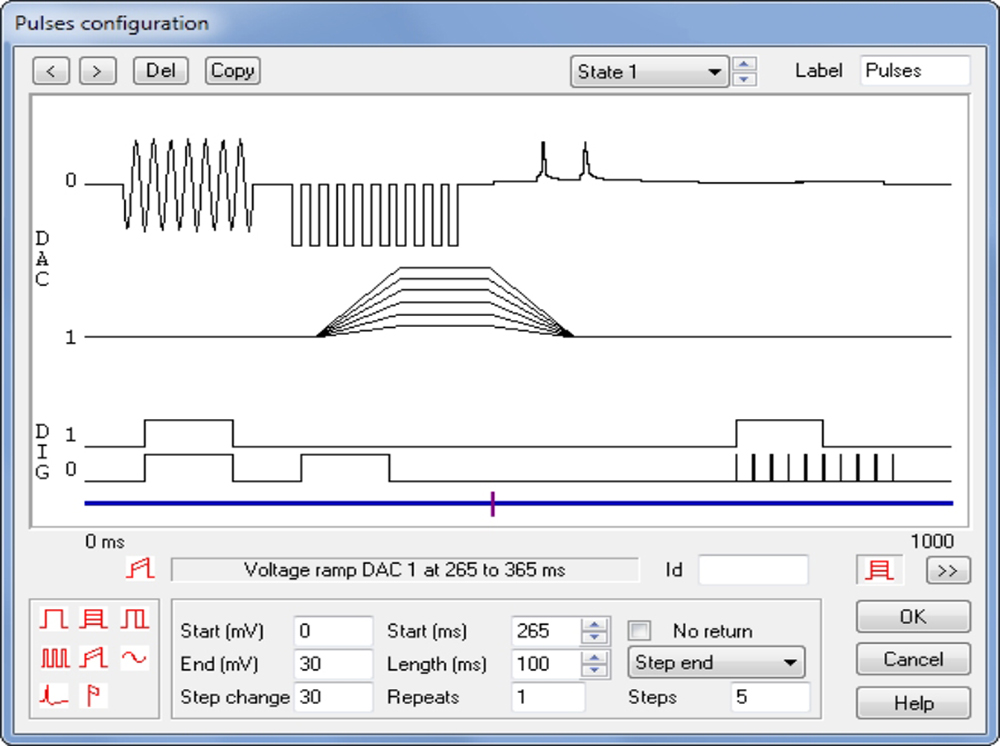
Clamp Specific Sampling Support
- Nominate a particular recording state to be used for seal and membrane resistance measurements.
- Easy adjustment of holding potentials.
- Dynamic readout of seal resistance.
- Membrane analysis option displays measurements of total resistance, access and membrane conductance, capacitive transient decay time constant and membrane capacitance.
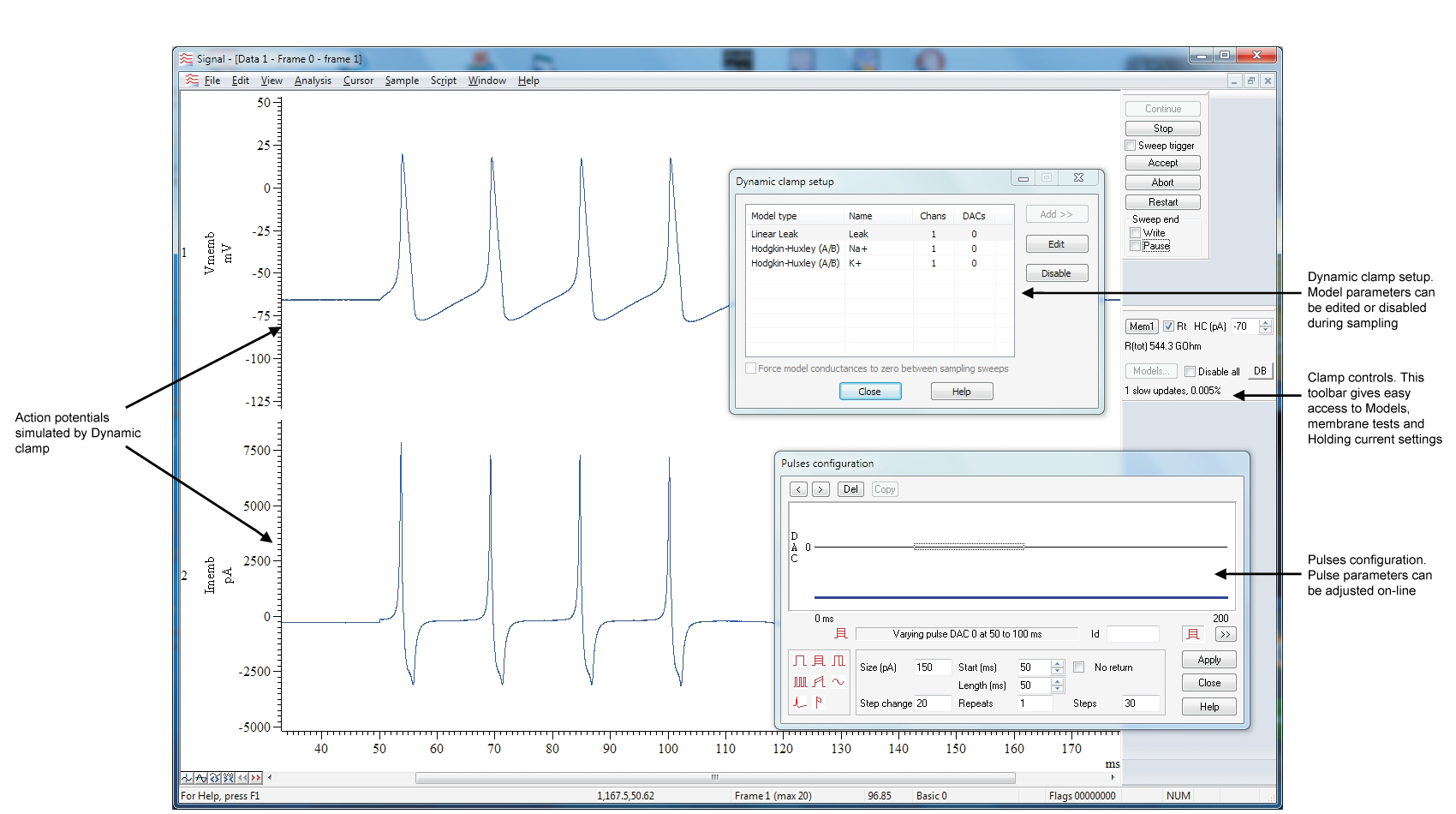
The Power1401-3 is CEDs high-performance data acquisition unit compatible with both Spike2 and Signal software suites. Faster clock and more memory translates to all the power and flexibility required in a state fo the art laboratory acquisition system.
| Catalog # | Name | Price | |
|---|---|---|---|
|
953180
|
1401 Data Acquistion Unit (1 MHz) |
Price:
$10,500.00
|
|
|
953200
|
Expansion ADC16: Top Box With 16 Input Channels |
Price:
$2,455.00
|
|
|
953220
|
Expansion: Signal Top Box With 8 Inputs, 6 Outputs |
Price:
$2,700.00
|
|
|
953240
|
Expansion: Spike2 Top Box With 8 Inputs, 8 Outputs |
Price:
$2,620.00
|
|
|
953250
|
Expansion EVENT: 12-Channel Top Box |
Price:
$3,150.00
|




